Expedition 45 Preview
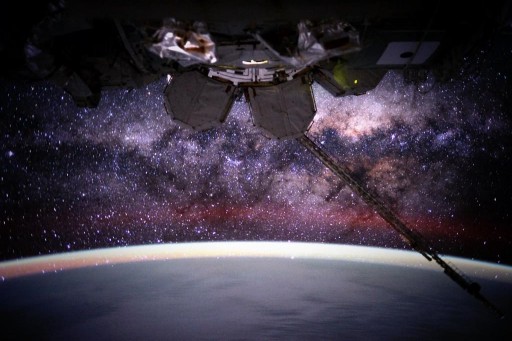
International Space Station Expedition 45 is a three-month Space Station Increment dedicated to the continued utilization of ISS as an orbiting laboratory for scientific investigations covering all fields of science. It is also dedicated to the ongoing reconfiguration effort in progress on the exterior of the U.S. Segment to prepare for the start of Commercial Crew Missions over the coming years. Expedition 45 is also hoped to see the return to flight of the Cygnus spacecraft, performing an interim mission launched by Atlas V, and SpaceX’s Dragon after it suffered an unfortunate launch failure earlier in 2015. Also making an arrival during the Increment will be the next two Progress spacecraft launching from Russia.
Expedition 45 begins with a direct handover between crews and a mission of two short-duration ISS visitors, necessary because of the ongoing one-year Expedition by Mikhail Kornienko and Scott Kelly that requires a change of Soyuz spacecraft because the vehicle is only certified to stay in orbit for 215 days. To facilitate the Soyuz switch, Sergei Volkov launches with two short duration crew members, Andreas Mogensen of ESA and Aidyn Aimbetov of Kazcosmos, who will trade places with Kelly and Kornienko – returning to Earth with Gennady Padalka to leave Kornienko and Kelly on ISS for a return with Sergei Volkov in March 2016.
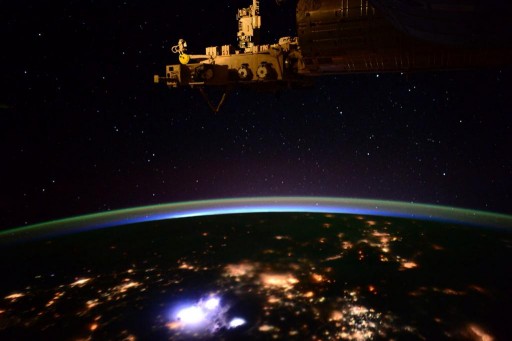
Formally, the start of Expedition 45 will be marked by the departure of Soyuz TMA-16M that will bring Padalka, Mogensen and Aimbetov back to Earth, leaving on ISS the two one-year crew members Scott Kelly and Mikhail Kornienko along with Sergei Volkov, Oleg Kononenko, Kjell Lindgren and Kimiya Yui. They will work together as part of Expedition 45 until December when another direct handover takes place which will require Soyuz TMA-17M to relocate from Rassvet to Zvezda – this time not because crew members are going to switch Soyuz craft but due to the orbital setup of ISS that requires the Soyuz to launch to the Station in early December in order to reach ISS on the fast lane while the homecoming Soyuz has to wait until later in the month to ensure its landing can take place in daylight.
Soyuz TMA-19M will launch with Yuri Malenchenko, Tim Peake and Tim Kopra on December 15 while Kononenko, Yui and Lindgren will make their return on the 22nd of December to be back on Earth in time for the holidays, marking the start of ISS Expedition 46.
Throughout Expedition 45, the majority of the crew’s time will be dedicated to science operations, supporting over 200 studies ongoing aboard the orbiting laboratory. Science supported by the Space Station spans across all branches from Earth and Space Science over physical science, technology demonstrations, biology, biotechnology, chemistry and human research to educational activities and student-run experiments.
One particular area of interest is human research, taking advantage of the environment aboard ISS to study changes undergone by the human body down to a cellular and biochemical level when being exposed to the space environment for an extended period of time to identify the underlying mechanisms of phenomena such as bone and muscle loss as well as immune system changes, changes to the fluid distribution within the human body and a series of other phenomena.
One major item is the collection of information needed for the development of countermeasures that will be used to limit the negative effects such as degradation of bone and muscle mass seen today so that humans can stay in space for long missions of up to several years.
To complete these studies, the crew of ISS will serve as test subjects themselves – performing regular sampling activities, tests of their cognitive abilities and a range of other tests, also looking at psychological aspects.
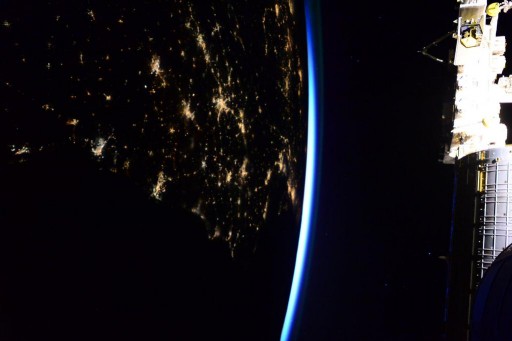
The one-year mission is the first of its kind conducted on ISS to deliver data that was previously unavailable. Gaining data on degradation occurring beyond the standard half-year mission will deliver extremely valuable insights needed in the development of countermeasures for future space missions that will last one year and beyond.
In addition to a busy science schedule, the crew of ISS Expedition 45 will support a series of visiting vehicles. While Expedition 45 is in effect, both the SpaceX Dragon and Orbital ATK’s Cygnus are expected to return to flight after both suffered unfortunate launch failures over the last year.
Cygnus – being grounded for over a year to await the first flight of an upgraded launch vehicle – will make an interim mission to ISS using the Atlas V for its trip to space that will allow the spacecraft to be filled up to the last brink, owed to the high performance of the Atlas V powerhouse.
Dragon will return to ISS when its Falcon 9 launcher is cleared for liftoff again after suffering a complex failure mechanism involving the Helium pressurization system of its second stage. Also during Expedition 45, two Russian Progress spacecraft will arrive at ISS including the first in the improved series of Progress MS spacecraft.
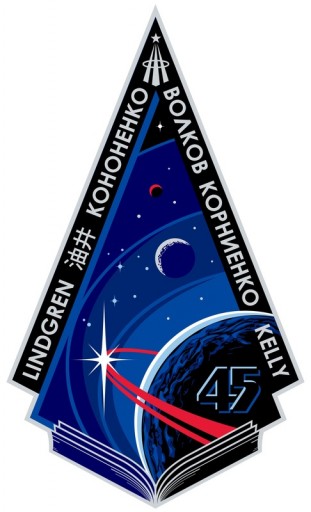
The Crew Patch
The International Space Station Expedition 45 crew patch prominently features the Book of Knowledge situated at the bottom of the patch to represent the foundation of the crew’s journey of exploration provided by past generations of pioneers, scientists and engineers.
The flow of knowledge is represented by the curves radiating from the book, also a symbol for the hard work and innovation necessary to make human spaceflight a reality.
The Space Station is represented by a single bright star soaring around the Earth, illuminating the path to more distant targets to be explored in the future on the foundation of knowledge built by the International Space Station. These targets are also featured in the patch – the Moon, Mars and more distant targets seen as small dots of light.
Also included in the patch are the names of the six Expedition 45 crew members – written in their native languages on the edges of the patch.
Expedition 45 Crew
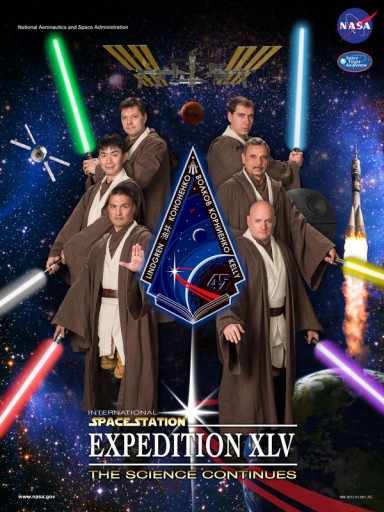
International Space Station Expedition 45 is highlighted by a crew that brings plenty of experience with the majority of crew members having flown at least one prior long-duration mission to the orbiting outpost.
Assuming Command of ISS for Expeditions 45 and 46 is Scott Kelly, one of the two one-year crew members who will spend the second half of his tenure as ISS Commander. Kelly is a former Captain in the U.S. Navy and also has an engineering background in aviation systems. As part of his career in the military, Kelly worked as a test pilot and logged over 8,000 flying hours. After his selection by NASA, Kelly served as a Pilot on Space Shuttle Discovery on mission STS-103 to the Hubble Space Telescope in 1999. His second flight was as a commander aboard Shuttle Endeavour for mission STS-118 that delivered the S5 truss to ISS. Launching on Soyuz, Kelly made his first long-duration mission to ISS as part of Expedition 25/26 in 2010/11. Overall, he logged 180 days in space as part of his three missions.
The other one-year crew member, Mikhail Kornienko has made one prior mission to ISS as part of Expedition 23/24, logging 176 days in space. He comes from an engineering background working on rocket engines, also specializing in EVA equipment and launch operations. He was selected as a Cosmonaut in 1998 but had to wait nearly 12 years to finally fly into space. During his mission to ISS, Kornienko performed one spacewalk of six hours and 42 minutes.
Oleg Kononenko is also no stranger to the International Space Station, having spent over one year aboard the orbiting outpost as part of two previous long-duration flights. He comes from an engineering background in space propulsion systems and was selected as a Cosmonaut in 1996, starting training under the International Space Station Program.
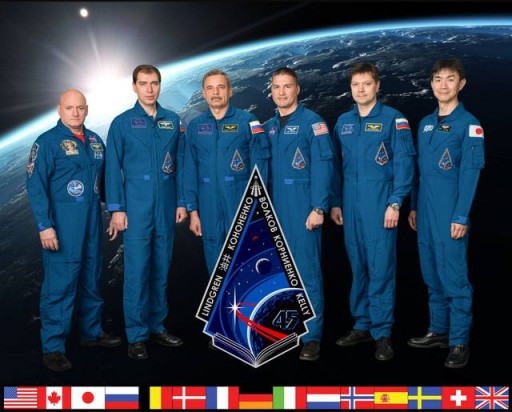
Crew re-shuffling required Kononenko to wait a few years for his first flight that took place in 2008 as part of Soyuz TMA-12 and ISS Expedition 17 followed by a second flight on Soyuz TMA-03M and ISS Expedition 30/31 in 2011/12. Overall, Kononenko logged 391 days in space and has performed three spacewalks for a total of 18.5 hours.
Kimiya Yui is a JAXA Astronaut selected in 2009, making his first flight into space. He can look back at a career in the military as a pilot, flying a series of Japanese aircraft as well as U.S. fighter jets. Yui was selected by JAXA in 2009 and trained alongside the 20th Astronaut Group of NASA. In 2012, he participated in the NEEMO 16 undersea expedition before being assigned to his long-duration mission to the Space Station.
Kjell Lindgren is a NASA Astronaut selected in 2009. He holds a doctorate in Medicine and Master’s degrees on Cardiovascular Physiology and Public Health and completed a three-year residency before joining NASA. After finishing a master’s thesis examining cardiovascular countermeasures in space physiology, Lindgren started working at the Johnson Space Center as a Flight Surgeon, support Space Shuttle and ISS mission operations, serving as the deputy crew surgeon on Shuttle mission STS-130 and ISS Expedition 24. He was selected as Astronaut in 2009 and was initially assigned to the ISS Expedition 42/43 crew before being transferred to 44/45 to facilitate the one-year flight to ISS.
Sergei Volkov is the first Cosmonaut in second generation, son to Aleksandr Volkov who flew to space three times in the 1980s and 90s. Volkov comes from a military background, serving as a fighter pilot, but his military career was rather short given his early selection as Cosmonaut in 1997. He made his first flight in 2008 commanding the Soyuz TMA-12 spacecraft and serving as Commander of ISS Expedition 17, becoming the youngest person to command the Space Station. He was one of the first crew members trained on the new Soyuz TMA-M spacecraft and commanded the TMA-02M spacecraft for a half-year stay on ISS as part of Expedition 28/29. In total, Volkov logged 365 days spent in space and performed three spacewalks for a total of 18.5 hours.
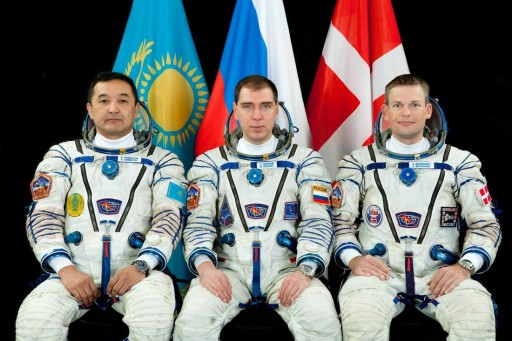
Both of the short-duration ISS visitors taking part in the handover between Soyuz TMA-16M and TMA-18M are space rookies.
Andreas Mogensen comes from an engineering background, working for a number of aerospace companies in research and development for a different missions including scientific missions. He was selected by the European Space Agency in 2009 and assigned to the short-duration IrISS mission in 2013.
Aidyn Aimbetov is one of two Cosmonauts selected by Kazakhstan in 2002. He comes from a military background, serving as a Pilot Engineer, and spent over a decade waiting for a flight to space, remaining in a flight-ready posture and finally catching a seat on a flight after Sarah Brightman withdrew from her Space Adventures tourist flight.
Visiting Vehicles
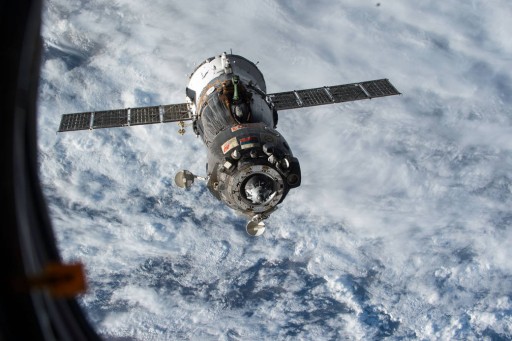
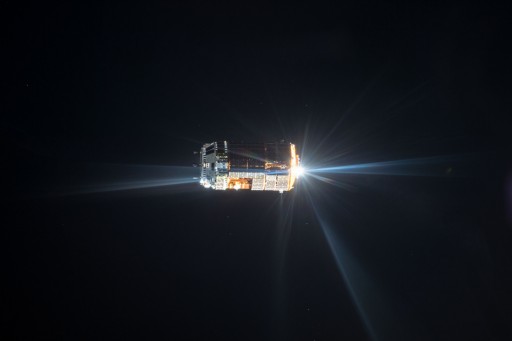
ISS Expedition 45 will be very busy from a Visiting Vehicles standpoint, seeing departures and arrivals on almost all docking ports available on the Space Station.
At the formal start of Expedition 45, the Soyuz TMA-16M spacecraft with spaceflight record holder Gennady Padalka, Andreas Mogensen and Aidyn Aimbetov on board will have just departed ISS, leaving the Zvezda aft port empty. Rassvet will be occupied by Soyuz TMA-17M of Kononenko, Lindgren and Yui while Poisk will accommodate the TMA-18M spacecraft for Volkov, Kelly & Kornienko. The last Russian docking port, Pirs, will be occupied by the Progress M-28M cargo craft. Residing on the US Segment will be the HTV-5 spacecraft.
The first Visiting Vehicle operation overseen by the Expedition 45 crew will be the departure of the HTV-5 spacecraft, set for late September. Concluding its five-week stay at the Station, the HTV will be closed out, have its hatch closed and be unberthed by the robotic arm. As ground controllers hand off to the crew members on board, they will release the craft that will then perform a gentle departure maneuver to move away from the Space Station for another pair of separation burns which will set it on a course to an independent orbit. HTV-5 will circle the Earth a few more times before firing its engines as part of a targeted deorbit maneuver, burning up in the atmosphere – loaded with trash and no longer needed items including three external payloads, SMILES, MCE and STP-H4. More information on the HTV-5 cargo overview page.
In the evening of October 1 (UTC), a Russian Soyuz U rocket will blast off from the Baikonur Cosmodrome, carrying the Progress M-29M spacecraft into orbit. Set for a fast-track rendezvous, the Progress will carry out four maneuvers in its first two orbits around the Earth followed by the initiation of its fully automated rendezvous sequence starting off with another series of maneuvers moving the craft in the immediate vicinity of the Space Station.
Using the trusted KURS navigation system, the Progress craft will make a fully automated rendezvous for a docking six hours after launch. Docking to Zvezda will not only mark the arrival of 2,350 Kilograms of cargo, but also give ISS a little help for propulsive maneuvers since the aft end of Zvezda permits uncomplicated maneuvers such as scheduled reboosts and short-notice Debris Avoidance Maneuvers.
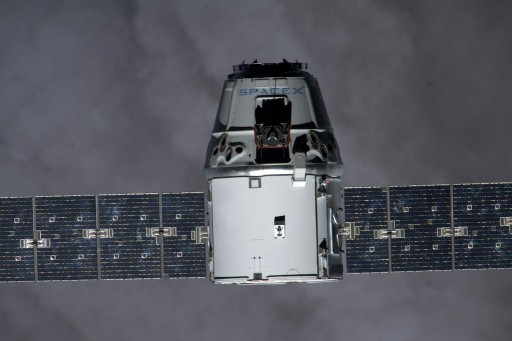
The next Dragon could arrive at the International Space Station as early as November, but the actual timing of the SpX-8 mission will depend on the Return to Flight progress of the Falcon 9 rocket. It is understood that the Return to Flight mission of the Falcon 9, also the first flight of the improved v1.2 version, will host the SES-9 satellite with SpX-8 taking the next flight, likely to take place before the end of the year.
Dragon SpX-8 will deliver to ISS a variety of pressurized cargo including plenty of scientific experiments and maintenance hardware while the external Trunk Section will facilitate the Bigelow Expandable Activity Module BEAM. The BEAM module is the first inflatable ISS module and is set for a stay of up to two years as part of a demonstration mission. To be robotically attached to the aft port on the Node 3 module, BEAM will be used as a storage module and a set of sensors will record the environment within the module. However, for most of the time, the hatch to BEAM will likely stay closed given the status of the module as an experimental addition to ISS.
Planned for November 19, Progress M-28M will depart the Pirs docking compartment to make room for the next Progress cargo spacecraft. Progress MS is set for liftoff atop a Soyuz 2-1A rocket on November 21, marking the first launch of the improved Progress MS spacecraft.
Progress MS is the latest evolution of the Progress cargo spacecraft. The overall design of the Progress spacecraft dates back to the 1970s and is based on the crewed Soyuz spacecraft. Progress made its first mission in 1978 to deliver supplies to the Russian Salyut 6 space station. Over the years, the design of the Progress spacecraft underwent a number of modifications and improvements. A number of spacecraft generations have flown to date, each featuring incremental upgrades to advance the design of the Progress as newer technologies became available while still retaining the overall design philosophy that has proven extremely robust and reliable with only a handful of Progress spacecraft failures.
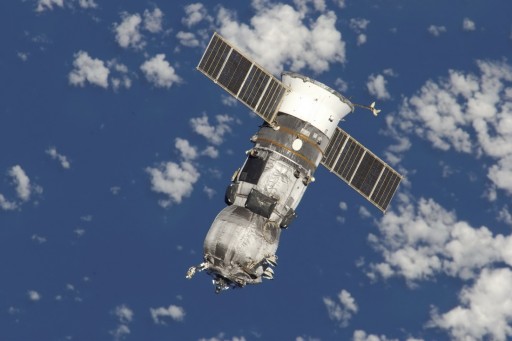
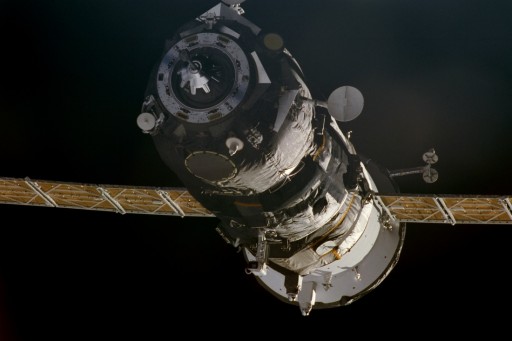
In keeping an overall commonality between the crewed Soyuz spacecraft and the uncrewed Progress cargo craft, the Russian space program has the unique capability of introducing new systems on the Progress spacecraft first, going through extensive evaluation on the uncrewed craft before being implemented on the Soyuz.
The same is true with the Progress M-M to MS upgrade since Soyuz will soon (March 2016) make its transition from the TMA-M to the MS version.
Major changes introduced by the MS upgrade of Progress include the replacement of the Ukrainian-built Kvant-V radio communications system with a Unified Command Telemetry System, ending Russia’s reliance on the Ukraine for the production of antennas, feeders and communication electronics. Furthermore, the new telemetry and command system of Progress MS is capable of using the Luch Geostationary Communications Satellites to relay telemetry to the ground and receive relayed commands during the portion of its orbit not in range of Russian ground stations.
Another communications upgrade of the MS series is the implementation of a Proximity Communications Link established with the Space Station during rendezvous to enable relative navigation as an additional source of navigation data. Progress MS is outfitted with GPS and Glonass receivers for accurate time determination, state vector calculation and orbit determination – allowing a more accurate targeting of burns, even by the spacecraft itself, no longer relying on radar tracking that is only possible during ground station passes.
The improvements made to the flight control system, onboard software and communications systems will also permit the switch from analog to digital video transmission for improved video quality during proximity operations. The KURS Navigation System makes a significant improvement in the newest generation of Russian Progress and Soyuz spacecraft, stepping away from the KURS-A system and implementing a new digital KURS-NA system.
The KURS System of the Progress and Soyuz Spacecraft is a radio-based system that allows the vehicles to perform a fully automated Rendezvous, Final Approach and Docking Sequence. KURS uses signals sent from the target vehicle that can be received by several antennas on the chaser vehicle to determine its line-of-sight and pitch angles for the far-rendezvous beginning at 200 Kilometers and pitch, heading and line of sight angles as well as range and range rate during the close rendezvous.
The KURS-NA eliminates any Ukrainian-built components from the system and provides an overall weight reduction while increasing the capabilities of the system. KURS-NA needs fewer antennas and will deliver more accurate measurements to bring Progress and Soyuz craft to a fully automated docking with the Space Station.
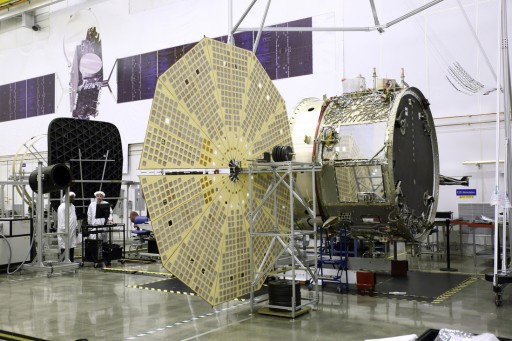
Cygnus is set for its interim mission in December. Suffering a dramatic launch failure, Orbital’s Antares rocket failed to deliver the Cygnus Orb-3 spacecraft to orbit in October 2013. Subsequently, Antares was grounded for a detailed inquiry into the failure that quickly focused on the rocket’s engines – converted NK-33 engines originally built for the Russian moon rocket in the 1970s. Although the engines were considered a cost-efficient and robust choice, they have proven to have more problems than expected – suffering a string of failures on test stands culminating in the Antares launch failure that occurred just seconds after liftoff, leading to considerable damage on the launch pad.
With Antares out of commission to be fitted with new RD-181 engines and ground facility repairs forecast to take over a year, Orbital ATK decided to keep its obligations to the Space Station Program by conducting an interim mission of Cygnus, contracting an Atlas V launch vehicle. Footing the bill for Atlas V, Orbital ATK will roll no additional cost over to NASA and expects to keep up its upmass quota specified under the Commercial Resupply Services Contract.
Launching on the Atlas V powerhouse will allow Cygnus – flying for the first time in its enhanced configuration with a larger cargo carrier and new solar arrays and navigation systems – to be loaded to maximum capacity, carrying a significant amount of cargo to ISS. The launch is provisionally set for the first week of December but dates may change as Atlas V launches progress.
Progress M-29M will have to depart the Zvezda module on December 9, after a stay of just nine weeks to make room for Soyuz TMA-17M that will make a relocation rom Rassvet to Zvezda in mid-December, itself making room for the next Soyuz arrival. Though direct crew handovers are no longer common aboard ISS, the changes in the Soyuz launch schedule due to the extended break in launches after the Progress M-27M failure have forced teams to conduct another of these handovers in December. Soyuz TMA-19M will launch on the 15th of December carrying Yuri Malenchenko, Tim Kopra and Tim Peake to ISS on the fast lane, making use of the four-orbit rendezvous – provided the orbital geometry with ISS can be kept up – something that did not work out twice this year because of phasing drifting out of place as a result of unscheduled ISS orbit changes.
With ISS staffed by a crew of nine for one week, Soyuz TMA-17M will be set for its departure on December 22, its undocking signaling the start of Expedition 46. The Soyuz craft can not land any earlier due to night conditions at the landing site throughout the first half of December. Night landings of Soyuz are generally avoided to permit an easy recovery of the spacecraft.
Spacewalks
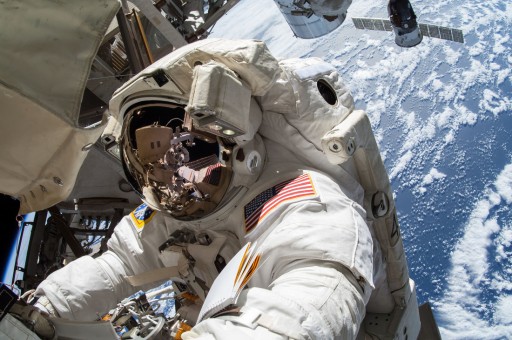
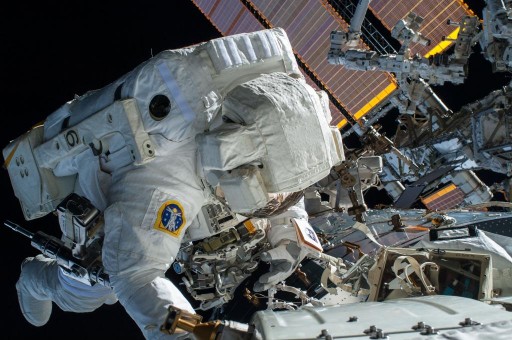
One, possibly two spacewalks are planned for Expedition 45, however there are a number of unknowns that will have an impact to the overall EVA schedule. One is the timing of the Dragon SpX-9 mission that will likely not occur prior to the end of 2015 which will push one EVA into the early 2016 time frame since hardware for this excursion will ride up to Station on the SpX-9 Dragon.
Another item of interest are the ongoing problems with the Space Suits on ISS, further complicated by the loss of a refurbished space suit in the Dragon SpX-7 launch failure. Teams are likely to clear the suits aboard ISS for EVA – pending the latest insights into the ongoing struggle with the now infamous Fan Pump Separators that keep causing trouble – beginning with Luca Parmitano’s close call in 2013 and dragging on into this year as FPS units continue to expire well before their planned end of life.
FPS Problem Background & Status:
Looking back at recent years, ISS had a number of issues with the EMUs starting in 2013 when a serious water leak emerged on Luca Parmitano’s space suit while he was working on the outside of ISS leading to a termination of the spacewalk and Parmitano reaching the safety of ISS just in time with water pooling around his head – covering his eyes, nose and ears when his helmet was taken off by the Station crew.
Through on-orbit testing and troubleshooting, teams traced the problem back to the Fan Pump Separator – a critical component that circulates oxygen through the suit while its pump transports the coolant fluid and the water separator removes water from the ventilation loop to condition the air that is returned to the crew member via the T2 port of the helmet. A detailed study was conducted to trace back the issue and NASA identified a rather complex mechanism that led to the failure of the EMU’s Fan Pump Separator due to a build up of silica contamination that originated within water support system of ISS that is regularly used to flush and replenish the water cooling system of the suits.
However, despite the elimination of what was thought to have been the root cause of the Fan Pump Separator issue, problems with the component and other suit parts continued to take up the crew’s time who often spent entire days inside the airlock performing suit maintenance. The Dragon SpX-3 mission delivered the #3003 suit to ISS and returned EMU #3015 to Earth after it exhibited issues with its sublimator and telemetry systems.
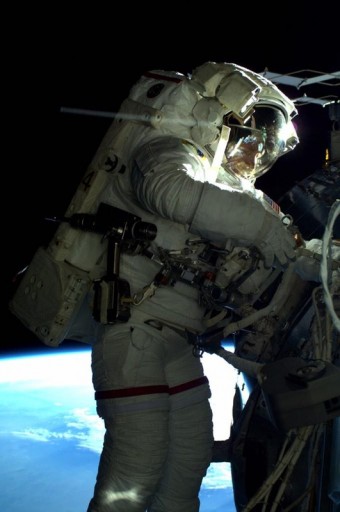
In October 2014, the Fan Pump Separator of EMU #3005 failed to spin up during an EMU Loop Scrub. After the FPS seized up on start, it was removed from the suit and replaced by a spare in December.
In January of this year, EMU #3011 showed a failure when attempting to re-start its Fan Pump Separator and troubleshooting could not recover the system. This required EMUs to be switched for a set of three EVAs that were conducted in February and March by Terry Virts and Barry Wilmore who used EMUs #3003 and #3005. The problematic FPS from the #3011 suit was returned to Earth by Dragon SpX-5 for detailed testing and further study of the ongoing issues with this particular component that had been in use for many years on the current EMU design.
In April, the crew went through a lengthy operation to swap the Hard Upper Torso sections of EMU’s #3005 and #3010 so that #3010 would become a size XL suit. EMUs #3003 (Size L) and the #3010 suit were considered the primary space suits with EMU #3005 as a backup.
However, during a regular test in late May, EMU #3010 showed insufficient cooling water flow due to an apparent problem with its Fan Pump Separator that had been installed on this suit since May 2014. Given the trouble with the Fan Pump Separators on all space suits on ISS, NASA continues to investigate the potential causes with great interest. The failed FPS was removed from EMU #3010 in early June and returned to Earth aboard the Soyuz TMA-15M spacecraft.
Possible 2015 EVAs:
Scheduled for the November 2015 time frame is the relocation of Pressurized Mating Adapter 3 from its current location on Node 3 to the Zenith Port on the Harmony Module (Node 2). This operation will be completed robotically, not unlike the relocation of the Permanent Multipurpose Module that made its way from Node 1 to Node 3 earlier in 2015. Finding its new home, PMA-3 is set to become one of two docking ports for the Boeing CST-100 and SpaceX Dragon 2 Commercial Crew Vehicles, alongside PMA-2 that resides on the forward port of Node 2.
To convert the PMAs, once used by the Space Shuttles, to docking ports for Commercial Crew Vehicles, they have to be outfitted with International Docking Adapters, IDAs for short. These IDAs follow the International Docking Standard and include power, data and fluid umbilicals that bridge connections from PMA and ISS to the visiting vehicles.
The first of the two IDAs was aboard Dragon SpX-7 and was lost when Falcon 9 disintegrated in the skies off the Florida coast. Already in final processing, the second IDA was set to launch on Dragon SpX-9 – a plan that still stands. When arriving on ISS, the IDA will be moved into place on the Pressurized Mating Adapter using the robotic arm, though the final structural connections and electrical connections will be made by the ISS crew as part of a spacewalk. Trained for this EVA are Scott Kelly and Kjell Lindgren, but given the grounding of Falcon 9, the scheduling will likely result in SpX-9 flying in early 2016 when Lindgren will already be back on Earth, requiring re-planning of the IDA-2 EVA.
Another EVA Kelly and Lindgren are prepared for is the outfitting of PMA-3, once in its new position on Node 2. During this spacewalk, the two crew members will route a number of electrical and data cables from pre-staged locations on Node 2 up the PMA and into position for connecting to IDA-3, once arriving on ISS as a replacement for the lost IDA-1. The majority of the cable work was completed as part of a set of EVAs performed in early 2015 that included routing bundles of cables from connection points on ISS to staging locations – either on PMA-2 or Node 2 Zenith to set up for the arrival of the IDAs and the relocation of PMA-3.
International Docking Adapter Background:
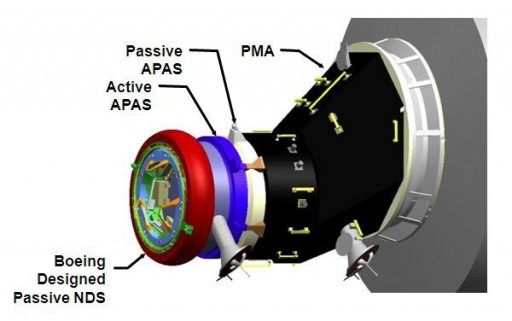
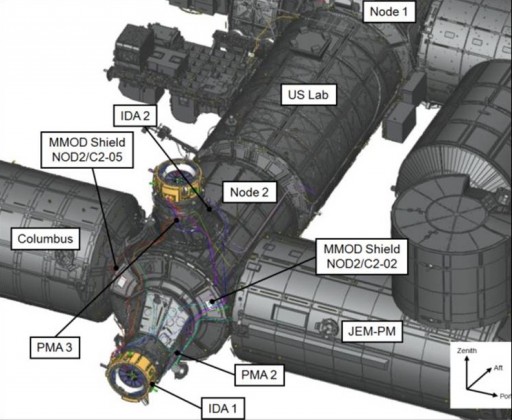
The International Docking Adapters (IDAs) will be installed on Pressurized Mating Adapters 2 and 3 to convert the APAS-95 docking interface used by the Space Shuttle to the NASA Docking System that is compatible with the International Docking System Standard.
The IDAs are compatible with the NASA Docking System which is an androgynous design supporting low-impact technology. Automated and piloted Spacecraft docking and robotic spacecraft berthing will be possible with the NDS. The docking interface includes architecture to transfer data and power between the two vehicles with future systems also capable of propellant, pressurant and water transfers. The hatch diameter available to crews is 80 centimeters.
For a docking, one interface is in active mode with its Soft Capture System extended while the other spacecraft is in a passive role with its SCS in a stowed position.
The Docking System includes a Soft Capture System that forms the initial connection between the spacecraft before pulling the two docking systems together to allow the Hard Capture System to form a rigid seal between the two spacecraft. Hooks are available on the active and passive side of the docking system, providing up to 24 attachment points. Overall, the system consists of a capture ring, guide petals, soft docking magnets, mechanical latches, magnetic striker plates, latch strikers and sensor strikers. The strikers are part of the passive system and provide contact surfaces for components of the active system. Soft capture can be achieved using magnetic or mechanical soft capture latches.
The first elements to make contact are the guide petals that then correct any lateral or angular misalignment between the docking interfaces with soft capture being achieved either through magnets making contact with the striker plates on the opposing ring or through active latches that capture passive latch strikers to from a soft-mate. The SCS then aligns the two docking rings and through the retraction of SCS, the two Hard Capture Interfaces are positioned within their hard capture range to allow fine alignment by the HCS guide pins. Hooks are then used on either the active, passive or both sides to establish the structural connection between the spacecraft and achieving the required force to press the seals within the docking system against the other spacecraft. Each side includes 12 hooks – the passive and active hooks can both be closed if dictated by vehicle requirements.
Due to the low force required for a Soft Capture, the NDS can support robotic berthing of a spacecraft.
To prepare for commercial crew, PMA-3 will be moved from Node-3 to Node-2 Zenith in July or August to be ready to welcome ISS visiting vehicles
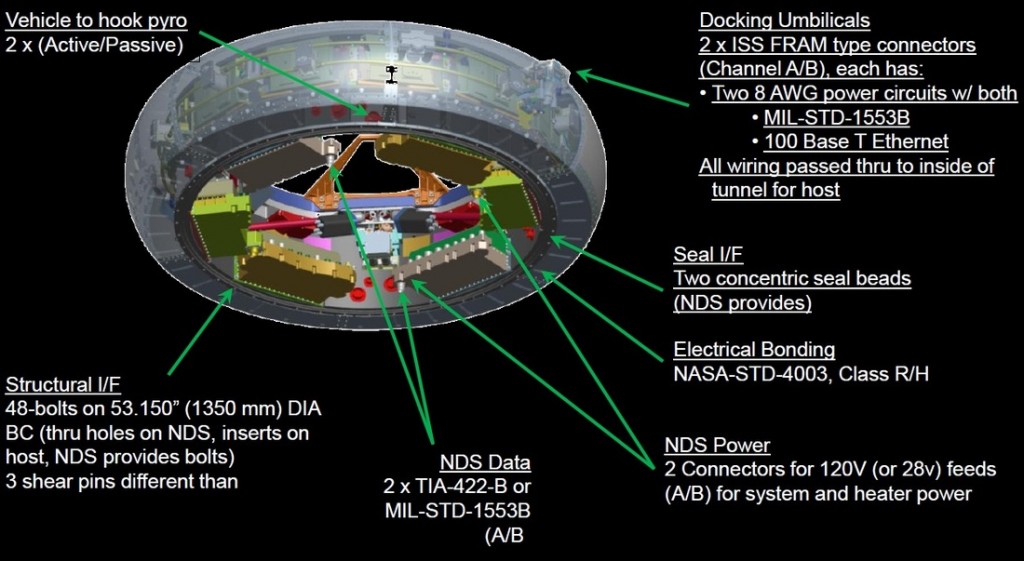
One-Year Expedition
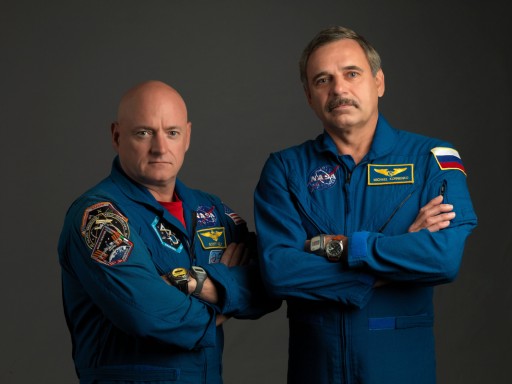
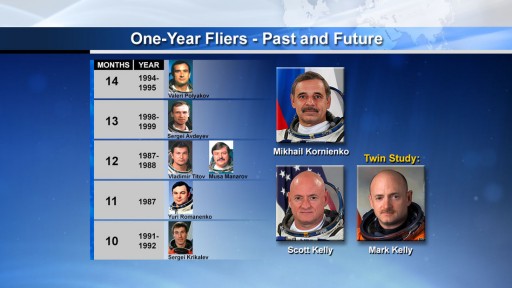
The idea of extending the duration of flights to the International Space Station to one year had been floating around for a while before NASA and Roscosmos agreed to conduct one such mission as a test, with each agency selecting one crew member to remain aboard ISS for one year. NASA had to choose from a number of applicants who were willing to commit to spending one year in space, selecting Scott Kelly for the mission who brings with him his twin brother Mark to participate as a ground control subject before, during and after the mission. Roscosmos selected veteran ISS crew member Mikhail Kornienko who already had a prior training experience with Scott Kelly as part of Kelly’s previous backup duty on Soyuz TMA-18. The official announcement of the one-year ISS mission was made in November 2012.
The one-year mission to ISS will not be the longest single spaceflight to be performed – four Cosmonauts have performed missions of one year and beyond, all to the Mir space station. At the top stands Valeri Polyakov with a mission of 438 days performed in 1994/95 followed by Sergei Avdeyev who spent 380 days in space in the closing years of Mir, from August 1998 to August 1999. Vladimir Titov and Musa Manarov performed a mission of exactly 365 days in 1987/88 aboard Mir. The longest mission to ISS was performed by the crew of Soyuz TMA-9, Mikhail Tyurin & Michael Lopez-Alegria in 2006/07 with a total duration of 215 days.
The space environment, characterized by microgravity and increased radiation exposure, has an effect on almost all bodily systems including physiological and psychological aspects. Typically, the physiological impacts of prolonged exposure to the space environment can be compared with an accelerated aging process – typical symptoms are a loss of muscle and bone mass, degradation of the cardiovascular and neurovestibular systems, and a significant degradation of the immune system. Balance disorders and behavioral changes are also observed in humans undergoing long-duration space missions.
For a six-month exposure to the space environment, abundant data is available through the previous Expeditions to ISS, Mir and the Salyut space stations, but crossing that threshold, only a handful of humans have ever undergone data gathering during a one-year flight. It is of great interest to see what happens between six and twelve months to extrapolate potential effects that even longer missions would have.
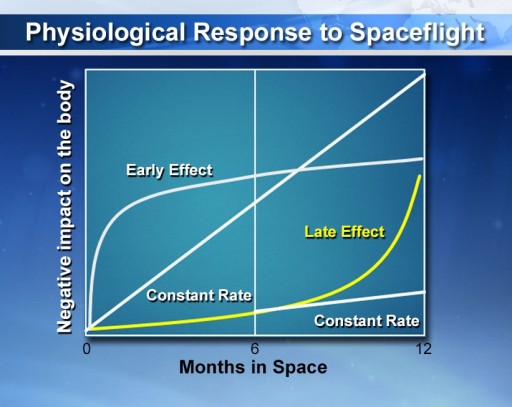
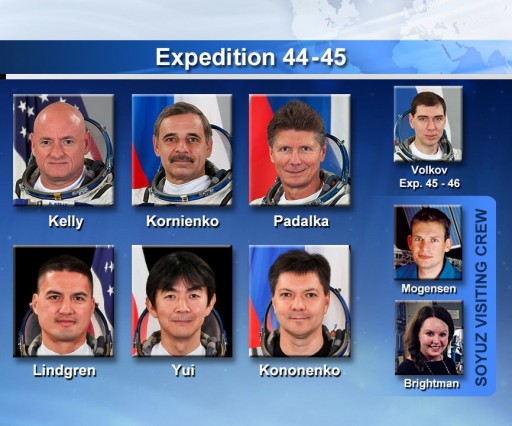
In the space environment, physiological degradation can occur on three different time scales – a constant rate that begins with the start of the mission and worsens over time at a constant speed, an early effect that manifests itself within the first weeks and months in space and then slows down in progression, and a late effect that is almost non-discernible during the first months in space before showing a rapid increase.
These late-effect physiological responses between the six-to-twelve month mission duration are the entire goal of the one-year mission to ISS. Even with just two crew members, the mission will identify risks associated with such effects that would need addressing for future missions to Mars and beyond.
The data delivered by Mir represents only five data points that are very basic, e.g. looking at a crew member’s ability to exercise over the course of the flight and post-flight health assessments, but lacking the in-depth look at the precise changes in different body systems or a study of potential mechanisms. With today’s technology, this first one-year mission will deliver a data set far surpassing those earlier missions.
The one-year ISS mission will be facilitated by inserting a direct handover at the six-month mark in the mission to keep up with the 200-day orbital certification duration of the Soyuz spacecraft which requires the two crew members to launch and land on different spacecraft.
The setup for the direct handover will begin on August 28, 2015 when Padalka, Kornienko and Kelly will climb into their Soyuz TMA-16M docked to the Poisk Module for a 30-minute relocation over to the aft port of the Zvezda module that will be vacated two days prior by the Progress M-26M spacecraft. This relocation is necessary to allow the two docking ports used for crewed missions (Poisk and Rassvet) to be available for the ‘regular’ Soyuz missions.
Soyuz TMA-18M will lift off atop a Soyuz FG rocket on September 1 for a fast-track rendezvous to deliver Sergei Volkov to ISS for his six-month mission who will eventually provide Kornienko and Kelly a ride home after their year in space is up.
Utilizing the two available seats up on Soyuz TMA-18M and down on TMA-16M are Andreas Mogensen, an ESA Astronaut conducting a short-duration science flight, and another yet to be determined crew member. The direct handover will last for ten days with nine people aboard ISS. Kornienko and Kelly will swap their Kazbek Seat Liners with Mogensen and his colleague to make the Soyuz switch official before Gennady Padalka takes the two short-duration fliers on their trip home on September 11.
Volkov, Kornienko and Kelly are expected to stay aboard ISS until March 3, 2016 for a flight duration of 184 days for Volkov and 342 days for Kornienko and Kelly.
Kelly Twins Study
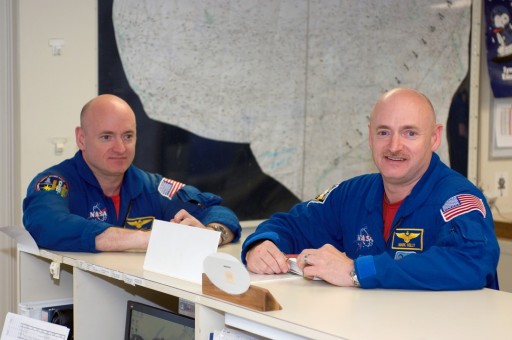
One of the unique aspects of Scott Kelly’s mission is the concurrent study of his twin brother Mark who will remain on the ground. Although Mark has retired from the Astronaut Office, he agreed to participate in this unique, once-in-a-space-program study.
Because Mark will be able to go about his normal business on Earth and not experience the same environment Scott will be experiencing, the twin study is considered observational in nature without any defined outcomes and objectives – it is considered a welcome opportunity to compare data collected from genetically similar astronauts to observe the human effects of spaceflight.
Data acquisition from the twins will include regular sampling activities of blood, saliva, swabs and stool as well as physical and psychological tests. A total of ten different studies were chosen for the twins:
- Metabolomic and Genomic Markers of Atherosclerosis as Related to Oxidative Stress, Inflammation, and Vascular Function in Twin Astronauts [This study looks at the effects of long-duration space flight on the cardiovascular system, investigating the relationship between gene expression, metabolomic profiles, biomarkers in blood and urine, and arterial structure and function. The experiment includes concurrent sample acquisition and exams from both twins – vascular function exam (ultrasounds of blood vessel function), blood & urine sampling at Launch minus 180 and 45 days, during the flight at +15, +60, +180, +240. +300 and Return-15 days, and three days after the return.]
-
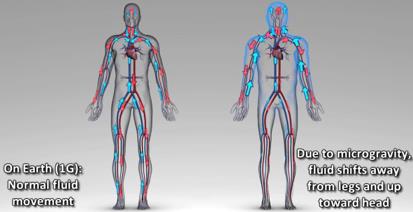
Image: NASA Proteomic Assessment of Fluid Shifts and Association with Visual Impairment and Intracranial Pressure in Twin Astronauts [Looking at fluid shifts is an important item in the current studies of spaceflight-induced changes in the human body since the fluid distribution on the ground is driven by gravity causing astronauts to exhibit ‘puffy heads’ and ‘chicken legs’ once gravity is no longer present. This particular study looks at the proteomic and genomic biomarkers underlying fluid shifts in the space environment as well as associated visual impairment and intracranial pressure symptoms. Since the study looks at the proteins present in the blood plasma, these sampling operations will be required from both twins. Additional measurements include ultrasound measurements of fluid shifts, intracranial & intraocular pressure, ocular structure, blood pressure, heart rate and vascular resistance. MRI and tissue hydration testing is performed pre & post-flight.]
- Cognition on Monozygotic Twin on Earth [This study focuses on behavioral health to characterize the effects a prolonged exposure to the space environment, the confined quarters of ISS and other environmental properties have on the perception and reasoning, decision making and alertness. The study includes questionnaires and behavioral tests performed before, during & after the flight.]
-
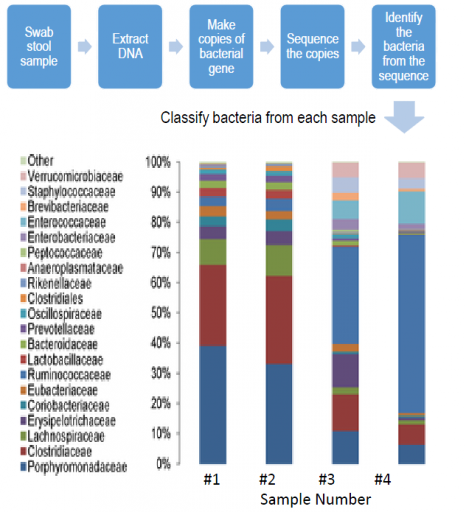
Metagenomic Sequencing of the Microbiome – Image: Northwestern University Metagenomic Sequencing of the Microbiome in GI Tract of Twin Astronauts [The population of the human gastrointestinal tract has an important effect on the overall health. The bacteriome can help in digestion and immune system function, but it can also have negative effects such as an overgrowth in bacteria that accompanies illness or stress. This study will look at the changes to the bacterial population of the GI tract over the course of a year and determine in what way they are different from changes observed on Earth. The investigation will look at particular types of bacteria susceptible to the space environment and also identify possible causes and consequences. The study will use stool swab samples to extract the DNA of bacteria that are then sequenced and identified followed by a classification from each sample taken at different times during the mission.]
- Differential Effects on Telomeres and Telomerase in Twin Astronauts Associated With Spaceflight [Telomeres are repetitive nucleotide sequences at each end of a chromatid serving the function of protection of the chromosome from deterioration and preserving the information-carrying sequences of the DNA. Aging on Earth is associated with the shortening of these repetitive sequences and can therefore be used as a biomarker of aging and age-related pathologies such as cancer and cardiovascular deterioration. This biomarker is able to capture the interplay between genetics and lifestyle factors – with two subjects with similar genetics (twins), the lifestyle factors (one in space, one on Earth) increase in their importance in the effect on the telomeres. The unique aspect of this study is that it reflects the combination of exposures such as radiation, and experiences – nutritional, psychological, physical and otherwise. The study will utilize blood sampling pre-flight as reference, during flight to asses short-term changes and for a lengthy post-flight period to look at long-term effects.]
- Comprehensive Whole Genome Analysis of Differential Epigenetic Effects of Space Travel on Monozygotic Twins [First, this study aims to compare the extent of DNA methylation between the two twins. Methylation, the addition of a methyl group to cystine or adenine DNA nucleotides, is one of the significant drivers in gene mutation and can be caused by external factors. This study tries to acquire samples at pre-determined intervals and based on unexpected exposures such as radiation events, or spacecraft contamination to link methylation to these spaceflight-related factors. Secondly, the study aims to assess whether effects seen in the space-flown twin are transient or long-lived. It will also be assessed whether mutations arise secondarily to epigenetic changes. Blood collection will take place at L-90, L-75, L+1, L+45, L+190, L+223, L+350 and R+90.]
- Biochemical Profile: Homozygous Twin control for a 12 month Space Flight Exposure [This study includes monitoring a range of biochemical parameters through blood and urine samples obtained from both twins. These parameters will reflect nutritional and physiological variables that may be altered as a result of the spaceflight experience and related nutritional changes, stress, microgravity and radiation. Data from this study will be able to improve the understanding of the role of the diet in the different biological systems. Blood and urine collection is performed at L-180, L-45, L-10, L+15, L+30, L+60, L+120, L+150, L+180, L+240, L+300, L+360, R+0 and R+30 days.]
- The Landscape of DNA and RNA Methylation Before, During, and After Human Space Travel [This study aims to uncover the genetic networks and expression patterns activated in the space environment, trace clonality of epigenetic changes and examine the extent of methylation of RNA. DNA methylation changes will be observed across the genome and a catalog of coding and noncoding RNAs will be observed to generate a transcriptome-wide map of RNA methylation sites. This will provide insight into potential mutation sites and associated consequences for long-duration space travelers.]
-
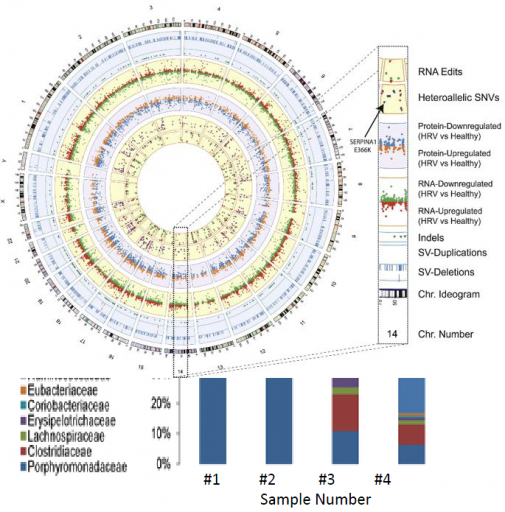
Image: Stanford School of Medicine Longitudinal Integrated Multi-Omics Analysis of the Biomolecular Effects of Space Travel [This study will collect all forms of data obtained as part of the various twin studies to create the most comprehensive portrait of the biophysical response to extended exposure to the space environment. Using the whole data set will allow scientists to detect and analyze even the most subtle changes in the twins’ physiology over time. This is done by following alterations to cellular systems that will help provide understanding of the effects of space travel on human health and how an astronaut’s genetic disposition may contribute to their unique physiologic response.]
- Characterizing Personalized Changes in Baseline Immune Abnormalities and Stimulated Immune Response in the Presence of a Benign Trivalent, Inactivated, Flu Vaccination [The space environment is known to have an effect on a person’s immune system. Taking two genetic similar subjects, one in space and one on Earth, will allow for a detailed study of spaceflight-induced degradation of the immune system over an extended period of time. The study will also characterize how long-term space effects change at baseline and after the seasonal flu vaccination. Baseline and post-vaccination are studied before, during and after the flight.]
Expedition 45 – Science Overview
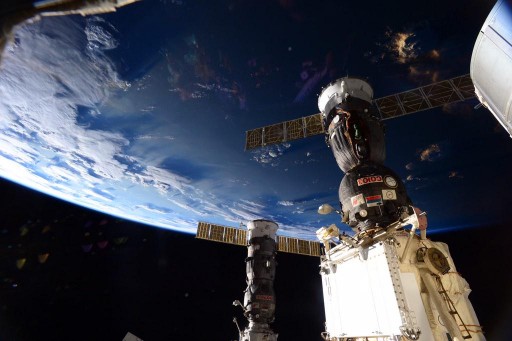
Continuing in its full utilization phase, ISS will feature a packed science schedule for the Expedition 45 crews who will be spending over 40 hours per week with the ongoing scientific research aboard the orbiting laboratory. Overall, ISS Expedition 45/46 will see more than 300 studies performed aboard the Space Station including around 60 Russian experiments.
Science highlights of Expedition 45 include the scientific use of the new rodent habitat aboard ISS to conduct in-depth studies of muscle and bone loss in mice during long-duration missions to space. These studies are supported by a new Bone Densitometer device that allows an objective assessment of bone density and body mass in space. In addition to the One-Year Crew’s science operations, ISS will continue supporting various new studies as well as experiments that have been part of the Station’s experiment schedule for several expeditions.
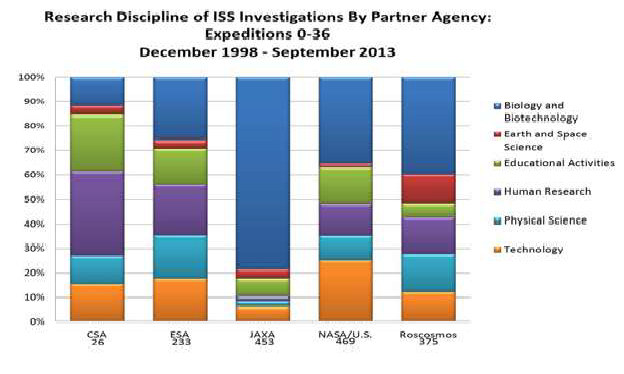
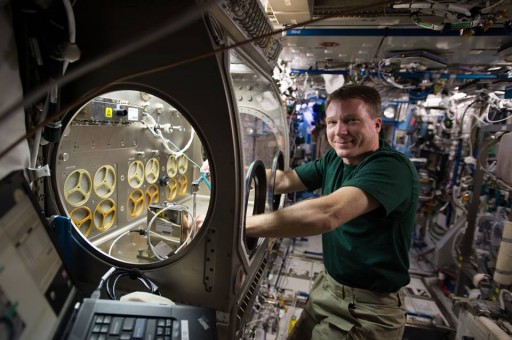
Expedition 45 will also feature the continued science operations of the Electromagnetic Levitator, a high-profile ESA science payload commissioned during Expedition 42.
In addition to a number of new studies, Expedition 45 will continue numerous experiments that started during previous increments. ISS Science spans across all fields of science with particular focus on Earth and Space Science, Physical Science, Technology, Biology and Biotechnology, Human Research and Educational and Cultural Activities.
The crew will be supporting hundreds of scientific studies and experiments that are in progress aboard the Station – often acting as test subjects themselves performing different experiments to study the effects long duration space flight has on humans.
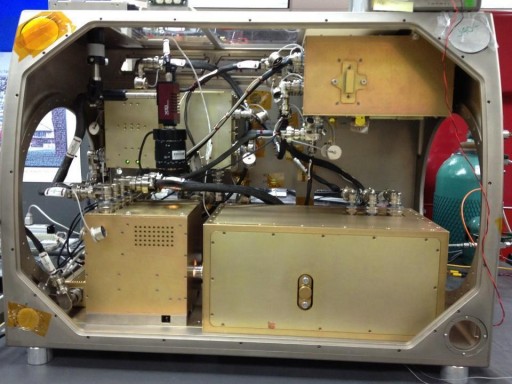
“Observation and Analysis of Smectic Islands in Space” will study the unique behavior of liquid crystals in microgravity with special focus on their overall motion and merging of crystal layers which is known as the formation of smectic islands. Liquid crystals are widely used in technology, being employed in LCD TV screens, laptop screens, watches and other electronics with flat panel displays. The also find use in soaps and membranes. Studying liquid crystals in microgravity will provide new insights into two dimensional system physics of complex fluids. Findings may lead to understanding of well aligned, very high speed electro-optic devices that could find use in embedded ferroelectric liquid crystal micro-displays.
The experiment assembly consists of a bubble chamber that is filled with medium, air jet injectors, ink injectors, LED lights and a camera assembly that monitors the activity inside the chamber. This setup will be used to study the various aspects of fluid crystal behavior in space – looking at overall fluid motion, diffusion, and the merging of crystal film layers.
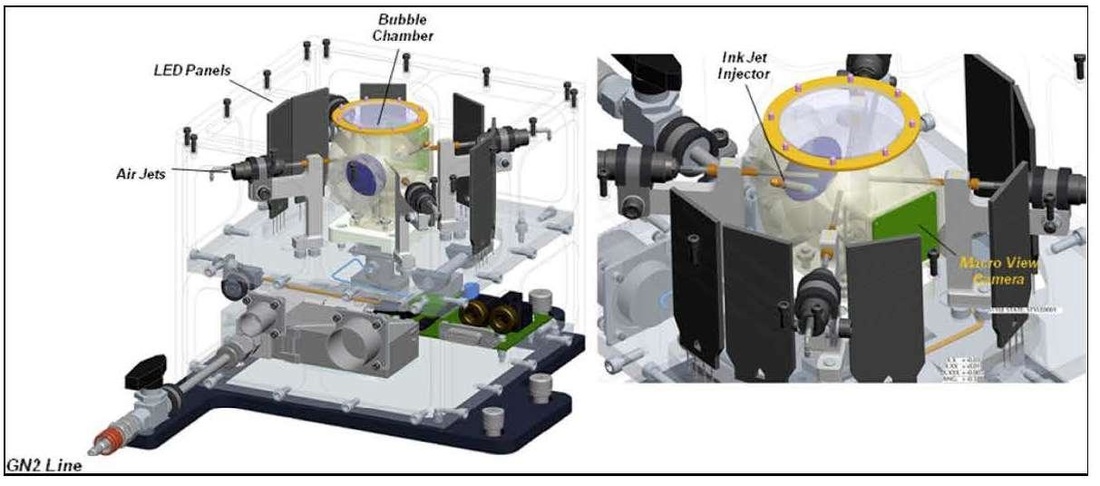
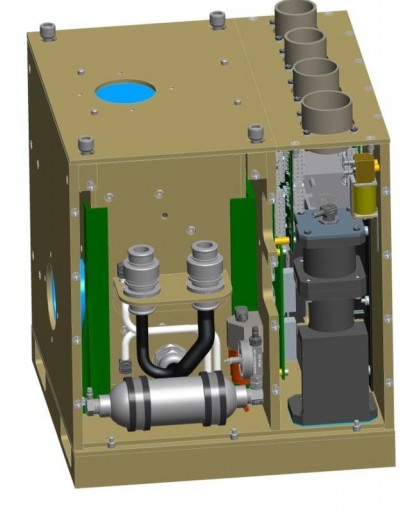
The experiment allows for a detailed study of complex fluid physics behavior in two dimensional fluids using freely suspended liquid crystals, focused on hydrodynamic flow, on relaxation of hydrodynamic perturbations, and on hydrodynamic interactions in two dimensions.
Precision studies of 2D hydrodynamics is possible in microgravity by using freely suspended bubbles without islands, convection, and sedimentation which represent nearly ideally homogenous (physical & chemical) systems. The introduction of islands / droplets in this system is recorded as controllable inclusions that modify flow and as markers of flow in the system. The experiment also looks at thermocapillarity of 2D fluids and collective systems of layer step interfaces on bubble surfaces.
Plant research will continue aboard ISS during Expedition 45 with a new study called “Utilization of the micro gravity condition to examine the cellular process of formation of the gravity sensor and the molecular mechanism of gravity sensing (Plant Gravity Sensing 1 and 2).”
The experiment looks at gravity sensing in thale cress, a generic model used in many plant studies. As part of the experiment, the plant is cultivated in microgravity and artificial gravity using a centrifuge to determine changes on a cellular level that point to the mechanism of gravisensing with particular focus on calcium channel activation through the MCA-1 protein.
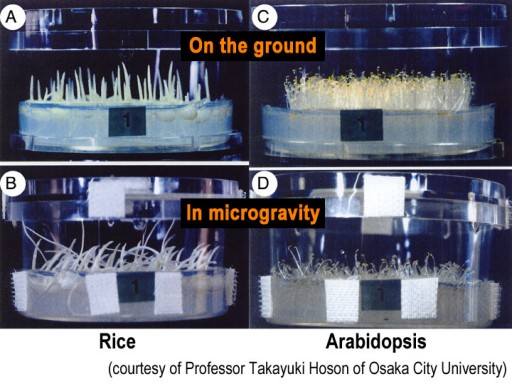
An increase of calcium within the cytoplasm of plants is known to occur in response to stimuli such as phytohormones, temperature and touch the mechanism of which has been studied extensively on Earth. Whether a calcium increase also occurs as a result of gravistimulation remains to be seen as gravity is difficult to control for ground-based tests. The mechanisms of underlying biochemical reaction paths that lead to gravitropism are fully unknown.
Recent studies point to a protein, MCA-1, and an actin cytoskeleton that are involved in the transport of calcium to create a directional response in the presence of gravity. The current hypothesis is that amyloplasts (starch containing particles) sediment in the direction of the gravity vector as a result of their high mass. This sedimentation causes tension stress in actin fibers thus activating the mechanosensitive calcium channels. Whether this system of channels and actin fibers also forms in microgravity is unknown.
The Plant Gravity Sensing 1 experiment will germinate cress seeds in a zero-G and a simulated 1G environment to be able to measure the calcium concentration and thus confirm whether the gravity sensing machinery is built in a microgravity environment.
Furthermore, the distribution of the MCA-1 protein will be examined to provide the reason for the changed calcium response since it will show whether the calcium channels are located in the appropriate locations in the cell membrane to allow a transfer. It is also possible that the MCA-1 protein is not synthesized properly in microgravity which will be determined via mRNA content measurements.
Findings from this study will find application in bioengineering on Earth to improve crop yields, but it is also useful for the development of operational plant-growth facilities in space to provide crews on long-duration missions with food.
The Osteo-4 Experiment, known by its full name of Osteocytes and Mechano-transduction, will examine the effects of the space environment on the function of osteocytes, cells that are deeply embedded in the mineralized matrix of bones.
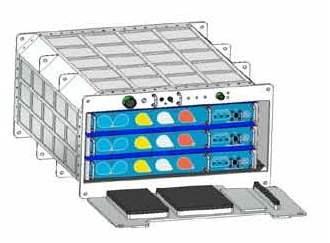
The role of these cells in bone-loss phenomena in space and in diseases occurring on Earth is evident when looking at their function of sensing mechanical forces applied to the skeleton and triggering biological responses. The mechanism of mechano-transduction is still poorly understood which is why the Osteo-4 study aims to examine gene expression in Osteocytes that are exposed to microgravity. This will lead to an understanding of mechano-transduction pathways and mineral ion regulation which could help in the development of therapies for bone disorders caused by disuse of immobilization.
The study will look at the response of Osteocytes to a lack of gravity to determine their response to mechanical unloading with special focus on a fibroblast growth factor that has been identified as a regulator of phosphate within the body’s phosphate-calcium homeostasis. Cells will be exposed to microgravity for short periods of time (3 days) up to prolonged exposures of ten days as part of this study before being returned to Earth for analysis.
Drain Brain – more formally known by its full name Strain-gauge Plethysmographic Analysis of the CErebral DRainage Experimented and Assessed in the Micro-gravitational Setting – is a new ISS study that will look at the flow of blood from the human brain back to the heart – a process that is normally driven by gravity. In space, with no gravity, other mechanisms are at work in this process which are to be identified by this experiment. It is known that crew members are often experiencing headaches (see Study ‘Space Headaches’) or other neurological symptoms that may be caused by insufficient blood flow through the veins due to an absence of gravity.
The Drain Brain study will use a neck collar to measure the blood flow from the brain to point to physical processes used by the body to maintain a blood flow from the brain to the heart in microgravity. The study uses Strain-gauge plethysmography, a non-invasive technique that measures variations in capacitance that are associated with changes in blood volume. These measurements are made through a stretch sensor worn around the neck. This technique has several advantages when aiming to put it in use in the space environment – it is non-invasive, non-operator dependent and requires a minimum amount of crew time for setup and maintenance.
In addition to its application to study cerebral circulation, the technology used in Drain Brain can also be employed on Earth to study venous blood flow in patients with heart- and neurological conditions. Researches are interested in studying the relationship between brain-related veins and cognitive disorders to see whether this novel system could be used to screen for vein abnormalities occurring in conditions such as Alzheimer’s disease.
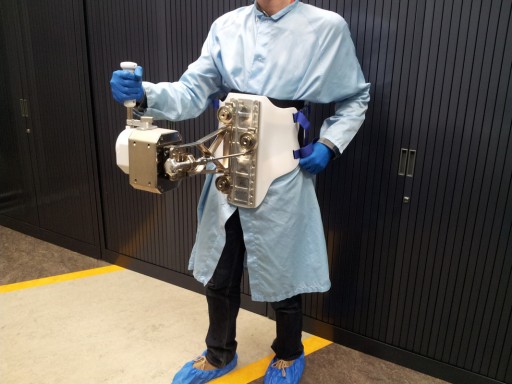
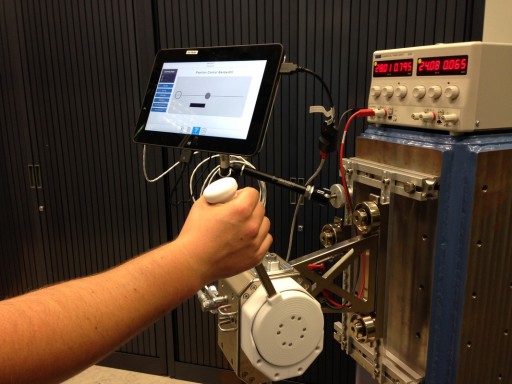
The new Haptics-1 hardware includes a single degree of freedom high-resolution force control joystick to be used in physiology research in zero-G with a technical element as this setup can find application in future space-telerobotics technology. The experiment will study how remote-controlled robot operation from space (telerobotics) can be accomplished with special focus on providing a haptic feedback to the controller in the form of force on the control device. This requires detailed knowledge on the effects of microgravity on force perception and motor control capability which has not been studied before.
The experiment hardware consists of a joystick that uses a highly power-dense brushless direct-current actuator, an EtherCAT motor controller, custom-built force and torque sensors and flight computer using Commercial off-the-shelf components. The Haptics-1 joystick is mounted via standard space station interfaces to a body harness.
Haptic feedback is extremely important for future telerobotics performed from space as it provides the controller with guidance as to how much force needs to be applied to complete a given job. This is already used on Earth, but for application in space, the examination of haptic feedback perception in astronauts in zero-G is necessary.
As part of experiment sessions, the astronaut can push and pull the joystick to complete simulated tasks that involve haptic feedback provided by the system that can produce minute forces that will be hard for most people to notice up to considerable resistance.
A total of seven different experiments are planned with the payload, although more can be easily uploaded to the instrument computer. The instrument is controlled via a touchscreen that builds the primary interface to the crew member.
For the experiment, crew members will be playing the computer game Pong – moving a bar on the side of the screen as precisely as possible under different feedback settings. Each experiment is accompanied by questionnaires that evaluate the smallest feedback a crew member could feel and how realistic the different settings feel. The experiments will be conducted at different points in the crew member’s mission to determine the effect of the mission duration on human motor control in microgravity.
The Haptics-1 experiment explores uncharted territory as it will answer the question whether the human body will be more sensitive to forces in space and how force perception changes over time during exposure to zero-G.
Telerobotics are expected to come into play in the future when astronauts control robots performing spacewalks on the exterior of spacecraft or telerobotically control rovers on Mars or an asteroid from a spacecraft in orbit.
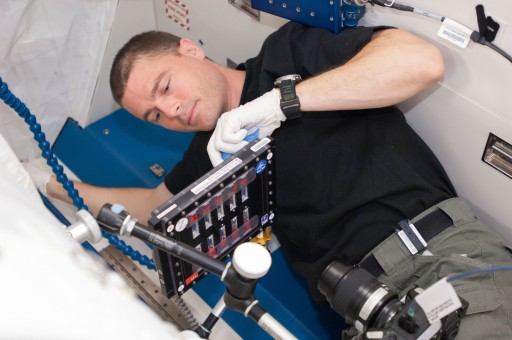
Another new study that build on previous experiments performed on ISS is BCAT-KP. The Binary Colloidal Alloy Test – Kinetics Platform builds on the success of the BCAT payloads that have been active aboard ISS since 2004. BCAT-KP provides a platform for material and industrial scientists to perform colloid phase change experiments in space in order to develop new colloidal materials and formulations with improved properties including new liquid-crystals with longer shelf life and new applications. The study will particularly look at the characterization of phase kinetics for emulsions in a low gravity environment.
The BCAT-KP platform features ten sample chambers that can be turned around quickly to facilitate a number of studies over the course of a year. The experiment requires the crew to set up the hardware and camera to take photos of the samples at close range for imagery downlink for analysis. BCAT-KP is performed over a series of 7 to 14-day sessions to monitor how homogenized samples evolve over an extended period of time to see when and how crystals form.
Expedition 43/44 will also see several experiment sessions using the two SPHERES satellites that are used as testbed inside the Station. SPHERES can be modified using different systems to perform a range of experiments, for example RINGS and Zero Robotics.
SPHERES stands for Synchronized Position Hold, Engage, Reorient, Experimental Satellites and involves two satellites that are used inside the space station to provide a miniature testbed to study maneuvering capabilities and spacecraft measurement systems.
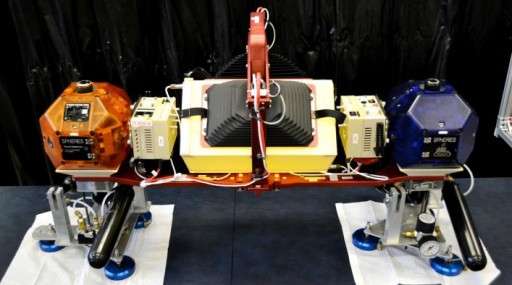
These two small satellites are used to study maneuvers in space in miniature inside the ISS.
The Slosh experiment investigates how liquids move around inside containers in microgravity. The physics of liquid motion in space are not well understood. A good understanding of the processes at work would improve modeling of the behavior of rocket fuel inside the tanks of satellites and other spacecraft or rockets. Computer models that exist have not been checked against actual experimental data acquired which is what this experiment will accomplish.
To conduct the experiment, the two SPHERES are attached to the assembled experiment hardware and the system is put through a series of maneuvers via the SPHERES satellites. Collected data will be downlinked for analysis.
A new JAXA study underway during expedition 45 is Aniso Tubule also known under its full name: Roles of cortical microtubules and microtubule-associated proteins in gravity-induced growth modification of plant stems.
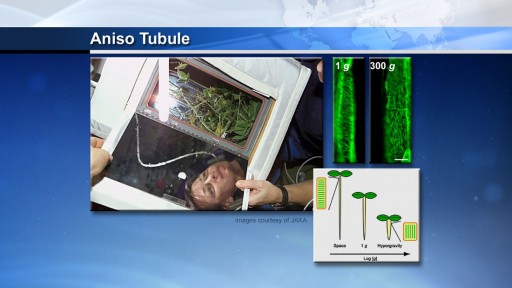
This biological study will fly plants to ISS to study how their microtubules, or tubular proteins, arrange themselves in microgravity directing plant growth and structure. On Earth, these microtubules arrange themselves transversely to provide support to the plant which is required to withstand Earth’s gravity.
In Hypergravity conditions with a much larger force acting on the plants, the tubules are arranged in a longitudinal fashion and the plants grow shorter and thicker so that they can withstand the greater force. Taking the plant-anisotropy principle to the next level is testing the hypothesis that plants would develop a long and thin body by changing orientation of cortical microtubule under microgravity conditions in space. And that is exactly what Aniso Tubule will accomplish.
A number of thale cress seeds will be flown to ISS and watered by the crew members to grow inside the Cell Biology Experiment Unit (CBEF) inside Kibo before being set in the JAXA fluoresces microscope in the JEM cabin that automatically observes the growth of the plants. This experiment could have direct application on Earth to improve plant production, but growing plants may also be indispensable during missions below Earth Orbit to other planets.
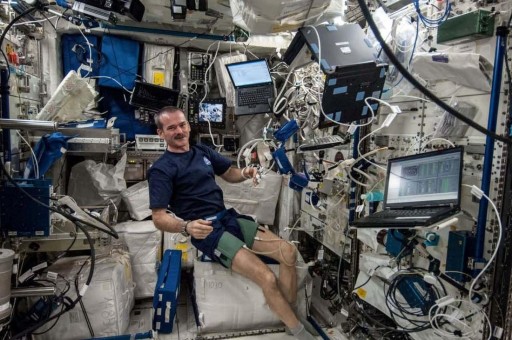
Other Studies that are continuing during Expedition 45:
SKIN B is a German Aerospace Center Payload that studies the the influence of microgravity on human skin. Crew members will complete at least eight experiment sessions during their flight. SKIN B measures skin moisture, water loss and studies physiological properties with a close-up imager. Skin elasticity, capillary blood flow and deep skin structure will be studied pre- and post-flight. On previous missions, it has been determined that the skin experiences a number of effects during long-duration space flights that resemble the aging process, but just in an accelerated form.
The BP Reg Experiment conducted by the Canadian Space Agency that involves data collection sessions before during and after a crew member’s long duration space flight to better understand why some astronauts are prone to fainting spells after returning to Earth. The study tests the efficacy of an in-flight manipulation of arterial blood pressure as an indicator of post-flight response to a brief stand test. When returning to Earth, crew members often have trouble maintaining a stable blood pressure when returning to an upright position.
“A Leg Cuff test will induce a brief drop in BP following the release of a short occlusion of blood flow to the legs. The change in BP from pre-flight to in-flight will be used to predict those astronauts who will experience the greatest drop in BP in the post-flight stand test,” a NASA document notes.
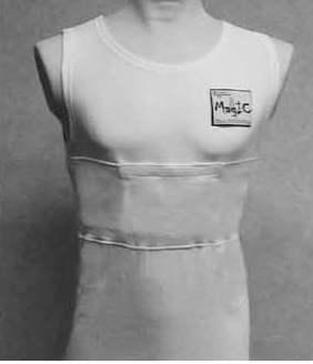
Monitoring a crew member’s biomed data without disturbing them during their daily business in space is a critical aspect of acquiring a vast amount of data needed for various studies in progress aboard ISS. Wearable Monitoring will validate a new cloth vest that has built-in systems that measures the astronaut’s heart rates and breathing patterns during sleep without waking them up or reducing sleep quality. The vest is a lightweight design with silver wires and sensors embedded into the fabric making it more comfortable to wear than a sensor harness. A similar experiment ran on the Russian Segment of ISS in recent years.
The overall goal of the first run of the Wearable Monitoring experiment is an assessment of astronaut’s sleep quality in the space environment. The system monitors heart and breathing activity, skin temperature, body accelerations, and indices of cardiac mechanics. These parameters will be used for an assessment of sleep physiology to understand the underlying mechanisms of poor sleep quality that is reported by many astronauts who are performing space missions.
Mechanisms of deterioration of sleep quality in microgravity are essentially unknown. Hypotheses suggest that autonomic subcortical arousals in the brain can cause a loss of sleep quality. These activations of the autonomic nervous system might be influenced by changes in cardiac mechanics caused by exposure to microgravity. Gathering data on cardiac mechanics during sleep and associated parameters may shed light on physiological mechanisms responsible for poor sleep quality in space.
The FLame Extinguishment Experiment 2 monitors the burning process of small fuel droplets to study the unique characteristics of fire in microgravity. The experiments looks at the rate and manner the fuel burns and the conditions that are necessary for soot to form. Also, the mechanisms of fuel evaporation before burning are studied to provide a better understanding of the burning process in space for improvements in liquid-fueled engines for application in space flight.
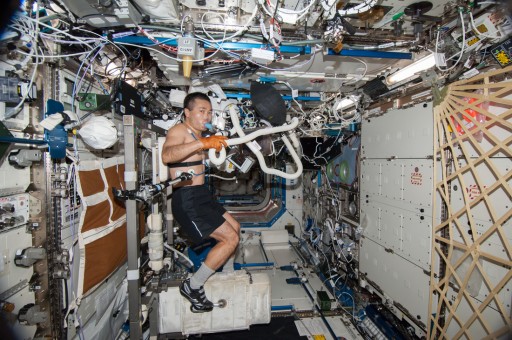
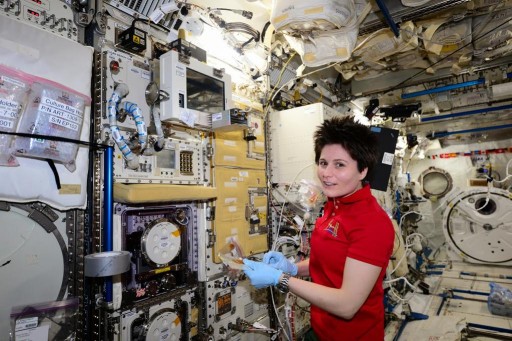
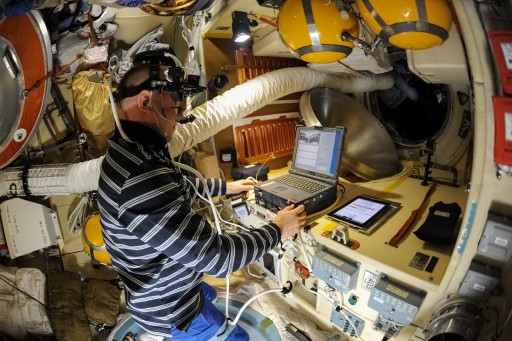
The European Space Agency will also continue operations of its Circadian Rhythms Study that will examine the role of synchronized circadian rhythms and possible maintenance during long-duration spaceflight and addresses the impacts to crew members’ health and wellbeing. Understanding how the dark/light cycle and sleep shifting affects circadian rhythms and with that the performance of the crew members will enable scientists to develop new sleep shifting techniques for crew members in space and shift workers on Earth.
The SPINAL study involves ultrasound scanning of the crew member’s spine over the course of their flight to assess the extent and impact of spinal elongation in crew members undergoing long duration space flight. Scans are performed 30, 90 and 150 days into a crew member’s mission. “Ultrasound images will focus on the cervical and lumbar areas of the spine and surrounding tissues. The test subjects will also undergo pre- and post-flight ultrasound and MRI scans on Earth to provide baseline data,” NASA said in a statement. The SPINAL study also seeks to advance medical imaging techniques for application on Earth.
In addition to continuing the US Reaction Self Test, the USOS Crewmembers will participate in the European Space Agency study called Pro-K. The Pro-K study involves a crew member sticking to a high or low salt diet over a several day period and log their diet, take blood and urine samples and analyses and store those samples. ESA Integrated Cardiovascular is another Study that is active for Increment 44. The ICV Experiment involves periodic resting Echo Ultrasound-Scan and ambulatory monitoring sessions to evaluate the extent, time course, and clinical significance of cardiac atrophy and identify its mechanisms.
Many other long term ISS Research projects will continue on Expedition 43/44 including many human research experiments focused on the effects of long duration flights on the human body. These tests include cardiovascular studies, studies of metabolism properties, etc. For that, the Astronauts will take regular tests (e.g. vision checks, electrocardiography) and give samples (Blood, Saliva, Urine) that will be returned to Earth for analysis.
On the Russian side, there are also a number of science operations that will be underway throughout Expedition 45. These experiments include material science, biology, human research, earth observation and physics&chemistry.
The new Biopolimer Experiment seeks to help in the development of new polymeric materials resistant to biocorrosion. The experiment uses a series of test specimens in sealed film packets also containing polymeric materials. After exposing the containers to microgravity for a specified amount of time, the hardware will return to Earth for analysis to determine the resistance of the different materials to biocorrosion in spaceflight conditions for future application in spacecraft construction.
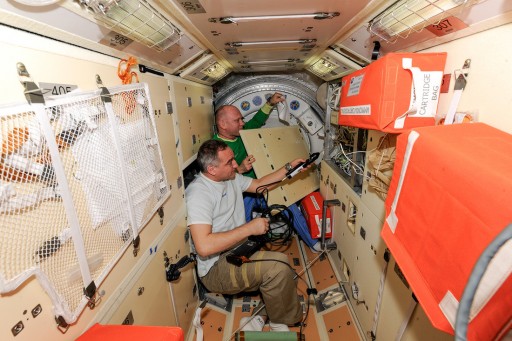
Matryoshka-R consists of a number of radiation dosimeters that are set up inside the space station to assess radiation exposure of the crew relative to ISS position in its orbit and shielding provided by the modules.
Obstanovka (=Environment) features external hardware including a set of magnetometers, wave sensors, potential probes, plasma discharge stimulators, an electron spectrograph and other components to study space weather. Obstanovka will study electromagnetic fields and plasma-wave processes occurring in the ISS Near Surface Zone to examine plasma component factors in near-Earth space. “The problems concerning the interaction of such super-large body as the International Space Station (ISS) with space plasma are of the top-priority importance for both technological and scientific experiments aboard the ISS,” the RSC Energia Experiment Overview document said.
Seismoprognoz will measure the temporal and spatial scales of ionospheric disturbances caused by seismic phenomena in order to develop algorithms to detect plasma features of earthquakes and anthropogenic impacts from space-based instruments. The payload consists of an external monoblock, a Data Control and Acquisition Module, an attachment kit, flash memory and associated cables and connectors.
‘Vzaimodeistviye’ (Interactions) looks at psychological aspects of long duration space flight during which different cultures come together aboard a Spacecraft such as ISS and seeks to improve crew interactions aboard ISS and with teams on the ground.
Relaxation is an Earth Observation Experiment that uses the Photospectral Hardware to acquire spectral and photographic imagery of Earth’s surface and atmosphere under ground commanding.
The KPT-10 telescience study examines “dynamic and structural characteristics of the Coulomb systems formed by charged dispersed diamagnetic macroparticles in a magnetic field (trap), investigating the following processes onboard the ISS RS (Russian Segment): condensed dust media, Coulomb crystals, and formation of Coulomb liquids due to charged macroparticles,” the NASA experiment overview notes.
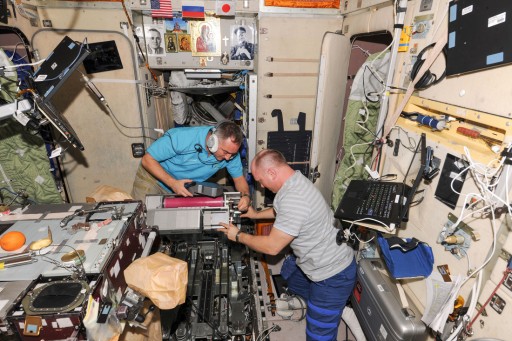
The PZEh-MO-8 Body Mass Study tracks a crew member’s body mass during their stay in microgravity which allows to examine the effects of diet and exercise in space. Measuring body mass in Zero-G, where matter is weightless, but not massless, is accomplished by measuring the inertial forces that arise during the oscillatory motion of a mass driven by two helical metering springs with known spring constants.
By logging the period of each oscillation of the crew member and comparing it to the period of a known mass, the unknown mass can be calculated.
Zero-G deconditioning is also being tracked by the MO-7 study that measures a crew member’s Calf Volume. These measurements are done with the IZOG device which is a custom-sewn fabric cuff that fits over the calf. The knee and lower foot of the left leg are used as reference points. The measurements provide a rough index of deconditioning in Zero-G and can be used to assess countermeasures.
The Russian MedOps Suite of investigations assesses crew health and other physiological changes occurring during long duration space missions by collecting samples of blood, saliva and urine of participants.
